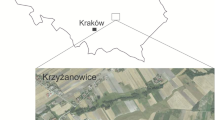Abstract
Culicoides chiopterus (Meigen), 1830 and Culicoides dewulfi Goetghebuer, 1936 (Diptera: Ceratopogonidae) are considered to develop exclusively in dung, but do not necessarily show an equal distribution and abundance on livestock farms in Northern Europe. Recent modelling studies identified soil parameters to explain these differences. The present study addressed the question whether topsoil conditions underneath cowpats correlate with the number of emerging C. chiopterus and C. dewulfi. We recorded the emergence of biting midges from 24 cowpats over a period of 4 weeks and analysed samples from the topsoil. In agreement with species distribution models based on remote data, our results detected the correlation of soil moisture, organic matter and soil texture with the number of emerging C. chiopterus and C. dewulfi. With increasing soil moisture, the number of emerging adults increased for both species and the amount of organic matter was positively correlated with the number of emerging C. chiopterus. In contrast, soil textures showed conflicting results, i.e. a positive and negative relationship with the same variables. According to our results, soil underneath dung can explain the number of emerging Culicoides species. The knowledge of these effects might improve the interpretation of large-scaled distribution models for dung-breeding biting midges.
Similar content being viewed by others
References
Campbell JA, Pelham-Clinton EC (1960) A taxonomic review of the British species of Culicoides Latreille (Diptera, Ceratopogonidæ). Proc R Soc Edinb Sect B Biol 67:181–302
Cannon LRG, Reye EJ (1966) A larval habitat of the biting midge Culicoides brevitarsis Kieffer (Diptera: Ceratopogonidae). Aust J Entomol 5:7–9
Carpenter S, Szmaragd C, Barber J et al (2008) An assessment of Culicoides surveillance techniques in northern Europe: have we underestimated a potential bluetongue virus vector? J Appl Ecol 45:1237–1245
Conraths F, Eschbaumer M, Freuling C, et al (2012) Bluetongue disease: an analysis of the epidemic in Germany 2006–2009. In: Mehlhorn H (ed) Arthropods Vectors Emerg. Dis. Springer Berlin Heidelberg, pp 103–135
De Regge N, Deblauwe I, De Deken R et al (2012) Detection of Schmallenberg virus in different Culicoides spp. by real-time RT-PCR. Transbound Emerg Dis 59:471–475
Dijkstra E, van der Ven IJK, Meiswinkel R et al (2008) Culicoides chiopterus as a potential vector of bluetongue virus in Europe. Vet Rec 162:422
Elbers ARW, Meiswinkel R, van Weezep E et al (2013) Schmallenberg virus in Culicoides spp. biting midges, the Netherlands, 2011. Emerg Infect Dis 19:106–109
Goodenough AE, Hart AG, Stafford R (2012) Regression with empirical variable selection: description of a new method and application to ecological datasets. PLoS ONE 7:e34338
Harrup LE, Purse BV, Golding N et al (2013) Larval development and emergence sites of farm-associated Culicoides in the United Kingdom. Med Vet Entomol 27:441–449
Kettle DS, Lawson JWH (1952) The early stages of British biting midges Culicoides Latreille (Diptera: Ceratopogonidae) and allied genera. Bull Entomol Res 43:421–467
Lühken R, Kiel E, Steinke S (2014) Impact of mechanical disturbance on the emergence of Culicoides from cowpats. Parasitol Res 113:1283–1287
Mathieu B, Cêtre-Sossah C, Garros C et al (2012) Development and validation of IIKC: an interactive identification key for Culicoides (Diptera: Ceratopogonidae) females from theWestern Palaearctic region. Parasit Vectors 5:137
Meiswinkel R, van Rijn P, Leijs P, Goffredo M (2007) Potential new Culicoides vector of bluetongue virus in northern Europe. Vet Rec 161:564–565
Mellor PS, Boorman J, Baylis M (2000) Culicoides biting midges: their role as arbovirus vectors. Annu Rev Entomol 45:307–340
Nevill H, Venter GJ, Meiswinkel R, Nevill EM (2007) Comparative descriptions of the pupae of five species of the Culicoides imicola complex (Diptera, Ceratopogonidae) from South Africa. Onderstepoort J Vet Res 74:97–114
Nielsen SA, Nielsen BO, Chirico J (2010) Monitoring of biting midges (Diptera: Ceratopogonidae: Culicoides Latreille) on farms in Sweden during the emergence of the 2008 epidemic of bluetongue. Parasitol Res 106:1197–1203
Peters J, Conte A, Van Doninck J et al (2013) On the relation between soil moisture dynamics and the geographical distribution of Culicoides imicola. Ecohydrology 7:622–632
Rasmussen LD, Kristensen B, Kirkeby C et al (2012) Culicoids as vectors of Schmallenberg virus. Emerg Infect Dis 18:1204–1205
Saxton KE, Rawls WJ (2006) Soil water characteristic estimates by texture and organic matter for hydrologic solutions. Soil Sci Soc Am J 70:1569
Scolamacchia F, Van Den Broek J, Meiswinkel R et al (2013) Principal climatic and edaphic determinants of Culicoides biting midge abundance during the 2007-2008 bluetongue epidemic in the Netherlands, based on OVI light trap data. Med Vet Entomol 28:143–156
Viennet E, Garros C, Lancelot R, Gardes XAL, Rakotoarivony I, Crochet D, Delecolle J-C, Moulia C, Baldet T, Balenghien T (2011) Assessment of vector/host contact: comparison of animal-baited traps and UV-light/suction trap for collecting Culicoides biting midges. Int Pest Control 53:201
Zimmer J-Y, Brostaux Y, Haubruge E, Francis F (2014) Larval development sites of the main Culicoides species (Diptera: Ceratopogonidae) in northern Europe and distribution of coprophilic species larvae in Belgian pastures. Vet Parasitol 205:676–686
Zuur AF, Ieno EN, Walker N et al (2009) Mixed effects models and extensions in ecology with R, 1st edn. Springer, New York
Acknowledgments
We would like to give special thanks to Esther Timmermann for technical assistance during data collection. Furthermore, sincerest thanks are given to the farmer families who supported our study.
Author information
Authors and Affiliations
Corresponding author
Rights and permissions
About this article
Cite this article
Lühken, R., Kiel, E., Steinke, S. et al. Topsoil conditions correlate with the emergence rates of Culicoides chiopterus and Culicoides dewulfi (Diptera: Ceratopogonidae) from cowpats. Parasitol Res 114, 1113–1117 (2015). https://doi.org/10.1007/s00436-014-4284-z
Received:
Accepted:
Published:
Issue Date:
DOI: https://doi.org/10.1007/s00436-014-4284-z




